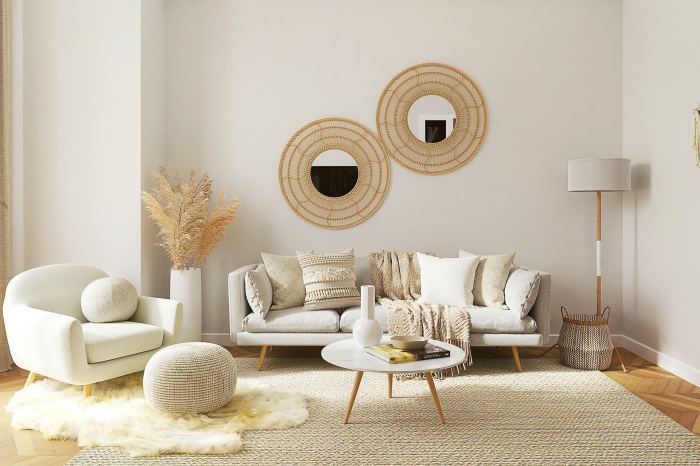Delving into Scandinavian interior design trends, this introduction immerses readers in a unique and compelling narrative. From the integration of sustainability to the use of natural materials and minimalist color palettes, explore the essence of modern Scandinavian design. Uncover the characteristics of iconic furniture pieces like the Egg chair and Eames lounge chair, and how Scandinavian furniture blends functionality with aesthetics.
Current Scandinavian Interior Design Trends

Scandinavian interior design continues to be a popular choice for many homeowners due to its clean lines, minimalistic approach, and focus on functionality. Let’s explore the top 5 trending elements in Scandinavian interior design, how sustainability is integrated into modern Scandinavian design, and the use of natural materials and minimalist color palettes.
Top 5 Trending Elements in Scandinavian Interior Design, Scandinavian interior design trends
- Light Wood: Light wood furniture and flooring are essential elements in Scandinavian design, creating a sense of warmth and brightness in the space.
- Hygge: The concept of hygge, which emphasizes coziness, comfort, and simplicity, is a key trend in Scandinavian interiors, with soft textiles, candles, and warm lighting playing a significant role.
- Functional Design: Scandinavian interiors are known for their practical and functional designs, with furniture pieces often serving multiple purposes to maximize space.
- Neutral Color Palettes: Neutral colors such as whites, grays, and earth tones dominate Scandinavian interiors, creating a sense of serenity and openness.
- Natural Light: Maximizing natural light is crucial in Scandinavian design, with large windows and light curtains allowing sunlight to flood the space.
Integration of Sustainability in Modern Scandinavian Design
Incorporating sustainability into modern Scandinavian design is a growing trend, with a focus on eco-friendly materials, energy-efficient lighting, and furniture made from recycled or repurposed elements. Designers are increasingly mindful of the environmental impact of their creations, aiming to reduce waste and promote sustainable living.
Use of Natural Materials and Minimalist Color Palettes
Scandinavian interiors are characterized by the use of natural materials such as wood, stone, and leather, which add texture and warmth to the space. Minimalist color palettes consisting of whites, grays, and muted tones create a sense of calm and simplicity, allowing the focus to remain on the clean lines and functional aspects of the design.
Popular Scandinavian Furniture Styles

Scandinavian furniture design is known for its minimalistic and functional approach, focusing on clean lines, simplicity, and natural materials. Let’s delve into some iconic Scandinavian furniture pieces and how they embody these design principles.
Iconic Scandinavian Furniture Pieces
Scandinavian furniture is characterized by its timeless and iconic pieces that blend functionality with aesthetics. Some of the most famous examples include:
- The Egg chair: Designed by Arne Jacobsen in 1958, this chair is renowned for its organic shape, comfort, and luxurious appeal. It exemplifies the Scandinavian design philosophy of combining form and function seamlessly.
- The Eames lounge chair: While not originally Scandinavian, this mid-century modern classic has become popular in Scandinavian interiors for its sleek design, comfort, and craftsmanship. It showcases the influence of Scandinavian design principles on a global scale.
Comparison with Other Styles
When comparing Scandinavian furniture with other styles like mid-century modern or industrial, some key differences and similarities emerge:
- Mid-century modern: Both Scandinavian and mid-century modern styles emphasize simplicity, clean lines, and functionality. However, Scandinavian design tends to have a more minimalistic and understated aesthetic, while mid-century modern often incorporates bolder colors and patterns.
- Industrial: Scandinavian furniture focuses on light colors, natural materials, and a sense of warmth, in contrast to the raw and rugged look of industrial design. While both styles prioritize functionality, Scandinavian design leans towards a more refined and elegant approach.
Functionality and Aesthetics
Scandinavian furniture is renowned for its ability to blend functionality with aesthetics seamlessly, creating pieces that are not only beautiful but also practical in everyday use. For example, a simple wooden chair may feature elegant curves for comfort while maintaining a sleek and modern look. This balance between form and function is at the core of Scandinavian design philosophy.
Obtain direct knowledge about the efficiency of Balcony railing design trends through case studies.